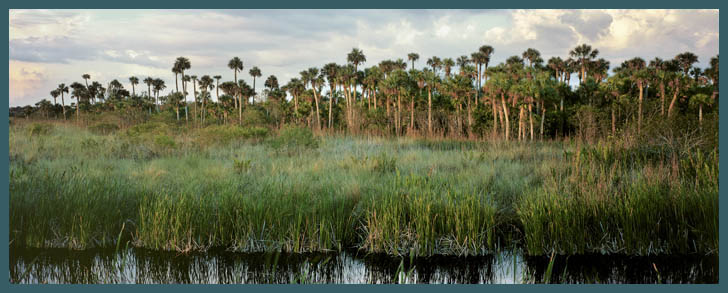|
Florida Everglades
K is for Katydids
Did you know that the best way to locate a singing katydid, day or night, is to follow the sound it makes while hidden? Meadow katydids, those who live in open damp or marshy areas, sing throughout the day, all the while perched on swaying blades of grass. Most species live for up to one year; however, some of the tropic species have been known to live for several years.
Katydids, from the family Tettigoniidae, contain more than 6400 species, with roughly 255 species located in North America and the majority in various tropical regions around the world. Katydids are relatives of both crickets and grasshoppers. They have oval-shaped wings, resembling leaves, and they grow over two inches in length. Male and female katydids make sounds while rubbing their forewings (front wings) together to 'sing' to each other.
One way to differentiate katydids from grasshoppers are their ears, which are small openings located just below the first joint on the front leg as opposed to the grasshopper's which are located on the sides of their bodies. And, they can also be distinguished from grasshoppers by the length of their filamentous antennae - which often exceeds its own body length, as opposed to the grasshoppers' relatively short and thickened antennae.
Some katydids are brown, some green, some have narrow wings while others have broad wings, but all have very long antennae, and slender jumping legs. Taxonomists, those who study the general principles of scientific classification, have divided the North American species of katydids into seven sub-families. These include, but are not limited to: cone-headed, gladiator, meadow, and even a pink katydid - bubblegum pink actually - a rarely seen type obviously due to predators. This coloring results from a condition called erythrism. We're told their safe haven is found in both pink and red flowers. And, surprisingly, red katydids have also been spotted. There is also the eastern thread-legged katydid found only in Florida and Georgia - which is the most slender katydid found in Florida. The green katydid is the most common Florida katydid.
Breeding season falls in the late summer or early fall and the eggs will hatch the following spring into nymphs which continue to eat and grow, while also molting several times until they reach adulthood. My research stated that parents do not take care of their offspring.
While katydids are primarily leaf-eaters, they also eat plant parts - such as flowers, bark, seeds and dead insects. Some of their known predators include spiders, ants, tree frogs, bats and birds, to name a few.
END
Additional Reading:
American Insects: A Handbook of the Insects of America North of Mexico, by Ross H. Arnett, 2000
Bug Zoo (for children), by DK Publishing, 2010, ages 4 to 8
Field Guide to Grasshoppers, Katydids, and Crickets of the United States, by John I. Capinera, Ralph D. Scott and Thomas J. Walker, 2004
Florida's Fabulous Insects, by Mark Deyrup and Thomas C. Emmel, 2000
Katydids & Bush Crickets: Reproductive Behavior & Evolution of Tettigoniidae, by Daryll T. Gwynne, 2001
The Songs of Insects, by Larry Elliott and Wil Hershberger, 2007
The ABCs of the Florida Landscape is written by freelance writer Maureen Sullivan-Hartung, a Naples resident for 30 years, who loves learning about all aspects of the local flora and fauna. Another passion of hers is local history and she authored a book in November 2010, titled, Hidden History of Everglades City & Points Nearby, published by The History Press in South Carolina. Check her website for the book's availability or additional information about the author for speaking engagements at www.maureenwrites.com.
msh112011
|

